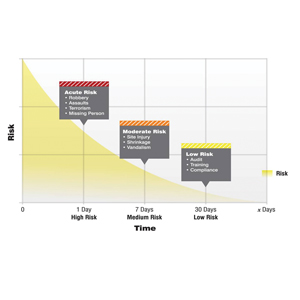
|
| TimeSight’s software is designed on the concept that as recorded video ages, the risk value is reduced. Without reprocessing the stored video, the cost of storage remains the same, as the value of the video to the end user is reduced. |
originally looking for and I find something else that I’d forgotten I owned.
While the Engebretson family has its own set of storage problems, our industry is running headlong into a major problem with the storage requirements for high-resolution megapixel IP cameras. There’s a seismic shift in end-user perceptions about what recorded surveillance video should look like. Grainy low-resolution video is out, and megapixel or HD IP-recorded video is in. Just as our clients are watching “CSI” on their high-def TVs at home, they are expecting high-resolution surveillance video recordings where people, license plate numbers, and specific identifying features can be extracted from their recorded cameras. Megapixel video excels in this area because it’s normally possible to zoom in to retrieve such details that are unavailable when zooming in to standard-resolution CCTV video.
We need enough hard drive space to store multiple megapixel cameras, and clients are demanding longer storage times. While 30 days of stored video used to be the standard, many clients are now requiring 90-plus days to protect themselves from costly “slip-and-fall” lawsuits and allegations of employment-compliance violations. Most of these same clients want their video stored at a minimum of 15 frames per second (fps), increasing the video storage requirements.
So let’s do the math. As an example, a megapixel IP camera set at 15 fps puts out an 8 megabits per second (Mbps) video stream. Hard drive storage space is characterized in bytes, where one byte is equal to 8 bits. So the 8 Mbps video stream is equal to 1 MB(yte) per second. Sixty seconds of video is 60 MBps, one hour is 3600 MB or 3.6 gigabytes (GB), with a gigabyte equaling 1,000 Megabytes. One day of recorded video is then 86.4 GB. Ninety days of recorded video will equal 7,776 GB, or 7.776 terabytes (TB), with a terabyte equaling 1,000 gigabytes. Now let’s pretend there is more than one camera (as there always are). If 20 cameras are to be recorded, the required hard drive space explodes to 156 TB.
What’s the cost for the hard drives? The current basic cost for a TB of hard drive storage is about $150 for a SATA drive. That doesn’t include the cost of the power supplies, boxes and racks to mount the drives. So the cost for the drives only in the example above for 20 cameras is $23,400, plus the accessories. The result is that the average market price per TB for video surveillance storage is between $750 and $2,000, depending on the manufacturer. Let’s not forget the cost of the AC power to spin the drives and the estimated cost to cool the drives so they function properly. It’s estimated that for every $1 spent to power computer devices (such as hard drives), it costs another $1 to cool them.
And if the recorded video is so important to store, then it must be backed up with some form of RAID setup or possibly tape backups. The bottom line is this: the cost of storage of the video can be higher than the wholesale cost of the cameras themselves, as megapixel surveillance cameras are now available for much less than $1,000 each at distribution outlets.
This is an ugly scenario for security dealers. We want to provide our clients with the best recorded video, but the storage costs can be a deal-killer. One vendor, TimeSight Systems, has developed a solution called Video Lifecycle Management (VLM), which provides video management software that dramatically reduces the hard drive size requirement, while retaining quality video for a specific time period.
To understand how the company’s storage software works, we need to think about how recorded video is used and the different amount of client risk potential that the recordings can represent.
TimeSight allows users to define periods of “Acute,” “Moderate” and “Low” risk profiles for the video. The “acute” stage is typically within the first week after a video stream is recorded. Certainly the end-user knows if he was robbed at gunpoint yesterday, so we need to have the highest quality video stored for relatively immediate viewing and analysis.
As time passes and the video ages and bad events haven’t emerged, then the risk profile is reduced to “moderate,” as this is a period where retail customers or employees may file lawsuits for various physical “accidents” that may or may not have occurred at the location.
TimeSight’s software will reprocess the video after the “acute” phase so that it takes much less drive space to store, while retaining a relatively high-quality reviewing capability. When the video is older still and the review usage is likely to be very low (possibly called upon for audit, compliance, etc.), TimeSight will further reduce the storage size of the video files during the “low” risk phase of the recorded video’s life span.
The Video Lifecycle Management software can reduce the size of the stored video files using up to three different methods. The first is dynamic compression, where the video is recompressed after certain time points have been reached. This provides the most significant hard drive savings, reducing file sizes up to 80 percent. The second method is variable resolution, which reduces the resolution of the video images over time. The third is frame dropping, whereby the number of images per second can be scaled back over time as users move from needing fine-grain detail to general awareness of what happened. The last technique is called motion optimized recording, whereby video segments that have no motion (no people) is recorded at a lower resolution, lower frame rate or much higher compression, while the recording levels are kicked up when motion is detected. This last method is perhaps the most useful, as the client will end up with a continuous recorded video stream with time-/date-stamped video frames for every second of every day being stored, retained accurate evidence that covers all time periods with no “blank” time periods and high-quality stored video when humans or other motion are present in the field-of-view of the camera.
As would be expected, all of the settings of the TimeSight VLM system are individually selectable for each camera feed.
Sounds good on paper, but what about real-world applications? At Stevens Creek Auto Group in San Jose, Calif., the client’s requirement was to use megapixel cameras and store the video for 100 days. Use of the TimeSight software system reduced the storage requirement from 30 TB to 3 TB — a 90 percent cost savings in hard drives alone, not to mention the rack space, power supplies, and power consumption and cooling costs.
High-resolution video storage for long periods of time will become a requirement from our clients. TimeSight provides a functional and practical solution that will dramatically reduce the cost of video storage, making high-end systems more affordable and therefore more saleable for our industry.
For more details on the VML solution, visit www.timesightsystems.com.






